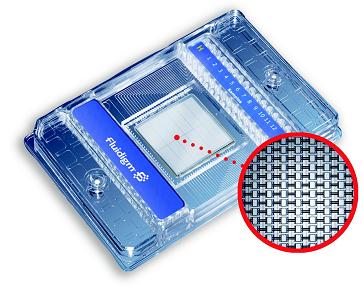Members Login

Channels
Special Offers & Promotions
Modelling The Genetic Circuitry Of Cell-To-Cell Communication
 Utilizing Fluidigm Corporation's Dynamic ArrayTM and Digital ArrayTM integrated fluidic circuits (IFCs), Stanford University researchers to have discovered a much larger spectrum of differences between individual cells than has previously been demonstrated. Among these differences are the communication capabilities that emerge from the interactions of genetic circuitry that mediates cell-to-cell communication.
Utilizing Fluidigm Corporation's Dynamic ArrayTM and Digital ArrayTM integrated fluidic circuits (IFCs), Stanford University researchers to have discovered a much larger spectrum of differences between individual cells than has previously been demonstrated. Among these differences are the communication capabilities that emerge from the interactions of genetic circuitry that mediates cell-to-cell communication.
The university also used Fluidigm support instrumentation for its cell culture chip as part of this groundbreaking analysis and modeling on how biological systems operate at the cellular level.
In a Stanford University School of Medicine press release, the institution researchers found that, "Cells don't all act in a uniform fashion, as was previously thought."
The Stanford press release continued, "Think of cells as musicians in a jazz band," said Marcus Covert, PhD, assistant professor of bioengineering and senior author of the study, published online in Nature June 27, 2010. Covert's lab studies complex genetic systems. "One little trumpet starts to play, and the cells go off on their own riffs. One plays off of the other."
Up to now, most of the scientific information gathered on cell signaling has been obtained from populations of cells using bulk assays due to technological limitations on the ability to examine each individual cell. The new study, using an imaging system developed at Stanford based on microfluidics, shows that scientists have been misled by the results of the cell-population-based studies, the Stanford release explained.
"This study represents a triple-play of Fluidigm capabilities. Steve, Markus and their teams used Fluidigm's Dynamic Arrays and Digital Arrays chips for a large portion of their work and some of our analytical instrumentation in operating the cell culture chip. Their work with cell culture coincides with development work that Fluidigm has underway to develop a Stem Cell Culture Chip for the commercial market under a grant from CIRM (California Institute of Regenerative Medicine)," said Gajus Worthington, president and chief executive officer of Fluidigm.
Fluidigm provides the most practical, efficient commercially available technology on the market to actually study individual cells. This technology enabled these Stanford researchers to look at thousands of individuals cells and conduct a multitude of tests on each cell.
In the Stanford press release, their researchers said "Population studies have not revealed the intricate network of information one observes at the single-cell level."
"This really surprised us," said study co-author Stephen Quake, PhD, a professor of bioengineering at Stanford, investigator of the Howard Hughes Medical Institute and a leader in the field of microfluidics. "It sends us back to the drawing board to figure out what is really going on in cells."
The study used a combination of Fluidigm 48.48 Dynamic Array IFCs to perform 2,304 qPCR reactions in parallel per chip. The cycle thresholds measured during qPCR reactions were converted into relative expression levels and those expression levels were calibrated for total mRNA molecules per cell using Fluidigm Digital Array IFCs performing digital-PCR measurements on a single gene.
"The study reports 'These results highlight the value of high-throughput, quantitative measurements, with single-cell resolution in understanding how biological systems operate.' We couldn't agree more," said Fred Walder, Fluidigm's Chief Business Officer. "The Fluidigm platform is uniquely matched to this emerging and critical biological research reality. As more scientists discover that single-cell understanding is key to life science research, we anticipate dramatically increasing interest and demand for our IFC platform products."
The study was supported, in part, by a National Institutes of Health Director's Pioneer Award, a National Cancer Institute Pathway to Independence Award, the Howard Hughes Medical Institute, a Stanford graduate fellowship and a Stanford Bio-X graduate fellowship. Quake is a founder, shareholder and consultant for Fluidigm.
A complete copy of the Stanford press release can be found at: http://med.stanford.edu/ism/2010/june/covert.html
A copy of the paper published in Nature Magazine can be obtained at: http://www.nature.com/nature/journal/vaop/ncurrent/full/nature09145.html
Fluidigm develops, manufactures and markets proprietary Integrated Fluidic Circuit (IFC) systems that significantly improve productivity in life science research. Fluidigm IFCs enable the simultaneous performance of thousands of sophisticated biochemical measurements in extremely minute volumes. These "integrated circuits for biology" are made possible by miniaturizing and integrating liquid handling components on a single microfluidic device. Fluidigm systems, consisting of instrumentation, software and chips, increase throughput, decrease costs and enhance sensitivity compared to conventional laboratory systems. For more information, please visit www.fluidigm.com
* Fluidigm, the Fluidigm logo, BioMark, Access Array, Dynamic Array, Digital Array, FC1, Topaz, and NanoFlex are trademarks or registered trademarks of Fluidigm Corporation. All other trademarks are the property of their respective owners.
Media Partners


